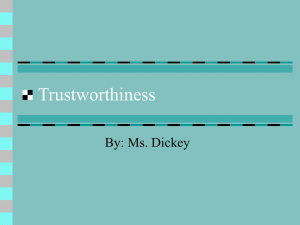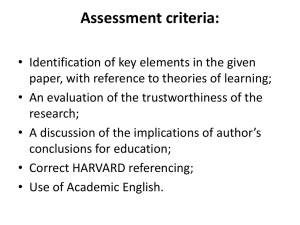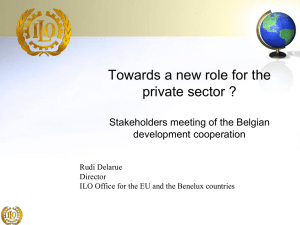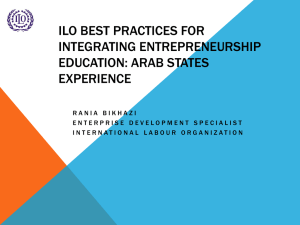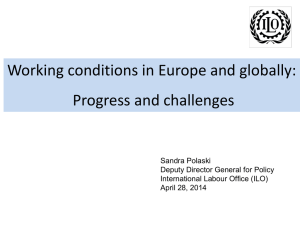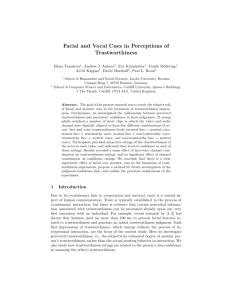Trust in e-learning systems
advertisement
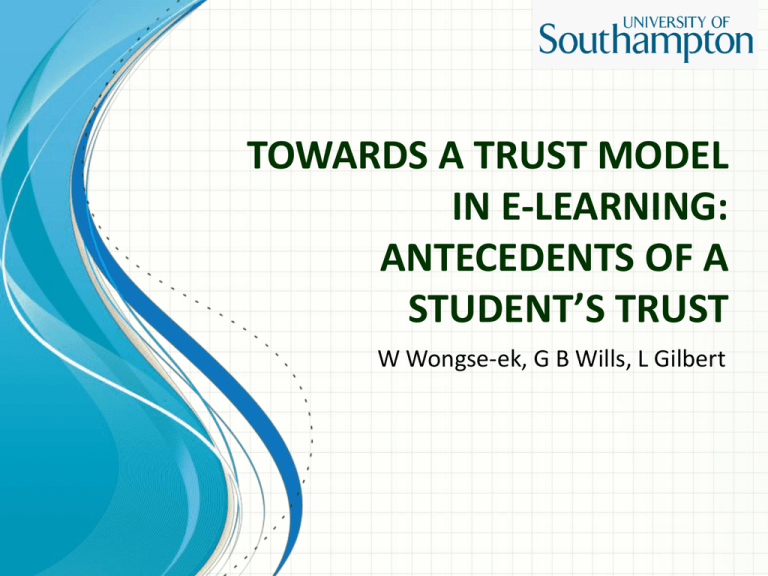
TOWARDS A TRUST MODEL IN E-LEARNING: ANTECEDENTS OF A STUDENT’S TRUST W Wongse-ek, G B Wills, L Gilbert Outline • • • • • Objective Motivation Related Works What is Student’s trust The Learning Outcome-based Trust (LOT) Model • Conclusion & Future work Objective • Explore antecedents of trust from perspective of student. • Contribute new conceptual trust model for calculating a degree of student’s trust in a learning activity. Motivation: Why trust model is needed? • Trust model is needed – to determine antecedents which significantly influence decision making to student’s trust. – to support machine accessible for calculating degree of student’s trust in learning activity. Related Works • • • • Student’s uncertainty Concept of Trust Learning Activity Structure Intended Learning Outcome (ILO) Related Works (cont.): Student’s uncertainty • Students face with uncertainty when – Encountering with new curricula. – Having variety choices of learning activities and materials • Student’s uncertainty can be reduced by increasing student’s trust in both learning activities and materials (Barnett, 2007) • Trust building maybe intended as a strategy to avoid unintended consequences of learning (Farini, 2012). Related Works (cont.): Concept of Trust – Trust is an individual expectation of outcome (Butler and Cantrell, 1984; McKnight et al., 1998). – Trust should be proportional to degree of quality and relevance of evidence of trustworthiness, or trust propensity (Larzelere and Huston, 1980; Wheeless, 1978). – Decision to trust can be split into two ways based on the trustor’s mental processes: predicting trust based on • (i) dispositional trust, and • (ii) rational trust. Related Works (cont.): Learning Activity Structure • A learning activity is how students act to extend their ability in order to achieve the desired learning outcome (dILO). • A learning activity can be written as a statement that consists of two main elements: a capability verb and the keywords. – The capability verb relates to a performance at one of the levels of Merrill’s CDT. – The keywords could be categorised based on the subject matter type in Merrill’s CDT. Related Works (cont.): Intended Learning Outcome (ILO) • Intended Learning Outcome (ILO) – ILO is intened learning outcome that expresses student's ability to perform activity by the end of the course (Kennedy, 2007). – ILO statement is presented as, “By the end of the course, the student will be able to X , where X is a performance”(Gilbert and Gale, 2008). – ILO consists of two primary elements: subject matter and capability – According to Merrill’s Component Display Theory (CDT) (Merrill, 1983), subject matter is classified into four kinds: Fact, Concept, Procedure, and Principle. The capability can also be classified into three kinds by using Merrill’s CDT: Find, Use, and Remember – ILOs diagram is used to represent learning tasks of student and guide teacher in planning the learning objectives for courses. (Tangworakitthaworn et al., 2013). Analysis of situation of student’s trust • situation of student’s trust in learning transaction – student is challenged with ambiguous learning activity in specific pedagogical situation. – student’s expectation is to achieve a desired learning outcome – student is willing to trust learning activity based on positive expected value of learning activity. – positive expected value could also be considered as perceived usefulness of learning activity or trustworthiness information of learning activity. – However, student’s prior competences and student’s trust propensity also influence the willingness to trust the learning activity. What is student’s trust in learning activity? • Our definition of student’s trust is “student’s trust is student’s own assumption to believe in learning trustworthiness, based on student’s own expectation of desired learning outcome in given pedagogical context”. LOT Model • The Learning Outcome-based Trust (LOT) Model – Student’s Assumption to trust – Student's Perception of Learning Activity’s Trustworthiness – Structure of Learning Context LOT Model (cont.) Student s Assumption to Trust Student's Perception of Learning Activity s Trustworthiness Student s Trust in Learning Activity Pedagogy Context Composed of LOT Model (cont.): Type of ILOs • The types of ILO and the learning task are defined in this research. The usage of ILOs and the learning task as source of trust will be shown in this proposed trust model. Types of ILO Descriptions Student’s desired learning The student’s desired competence is represented by outcome (dLO) using the desired learning outcome. Student’s familiar learning The student’s existing competence is represented by outcome (fILO) using the familiar learning outcome. Learning task e learning task is defined as a sequence of learning to achieve the desired learning outcome. An example of the learning task, which is represented by using a direct acyclic graph of ILOs, is shown in below figure. LOT Model(cont.): Student’s Assumption to trust ‘student’s assumptions to trust’ is defined as a notion of trust that a student considers to be true by themselves. • Student’s trust propensity is estimation of student position on ‘propensity to trust’ scale. • Student’s prior competence is the existing student’s ability or knowledge to do something successfully. • The student’s existing competence is represented by using the familiar learning outcome (fLO). Students' Trust Propensity Student s Assumption to trust Students' familiar Learning Outcome (fLO) Type of LOT Model(cont.): Trustworthiness of Learning activity The learning activity is analysed based on three properties: integrity, competence and benevolence, as shown in below figure. Integrity: Degree of all possible relations between the learning activity and the learning task Competence: Degree of the relation between the learning activity and the student s dLO Student's Perception of Learning Activity s Trustworthiness Benevolence: Degree of the relevance between the learning activity and the fLO Type of LOT Model (cont.): Structure of Pedagogy Context The pedagogy context is constructed based on the student’s desired learning outcome, the student’s exiting competencies, and the specific learning task. For What?: Distinguishing what student expects or wants to achieve For Whom?: Distinguishing characteristics of student by recognising pILOIdentifying student s existing competencies For Where?: Identify learning task and recognising where potential of student could be. For When?: Identifying readiness of student s existing competencies to accept knowledge in teaching activities at each stage. Pedagogy Context Composed of Conclusion & Future work • This research is aimed to focus on the new contribution – trust model in student’s perspective by considering trustworthiness based on the properties of the teaching activity, the student’s assumption and the pedagogical context. – trust model could be provided a measureable aspect of learning situation to compare the trustworthiness of the learning activity. • Future Work – to assists students to assess the trustworthiness of the learning activities for the selection of a suitable one – to gives artificial agents the ability to reason about trust. Students' Trust Propensity Student s Assumption to Trust Students' familiar Learning Outcome (fLO) Integrity: Completeness of Subject Matter If fILO with the Intended Learning Outcomes Schema (sILO). Competence: Weighting the Relevance between Student s Expectation of ILO (eILO) and Facilitating ILO of each Teaching Activity (fILO). Benevolence: Weighting the Relevance between Student s Prior Competencies (pILO) and Facilitating ILOs of each Teaching Activity (fILO). Student's Perception of Teaching Activity s Trustworthiness Student s Trust For What?: Distinguishing what student expects or wants to achieve For Whom?: Distinguishing characteristics of student by recognising pILOIdentifying student s existing competencies For Where?: Identify learning task and recognising where potential of student could be. For When?: Identifying readiness of student s existing competencies to accept knowledge in teaching activities at each stage. Pedagogy Context Type of Composed of QUESTIONS? & THANK YOU
